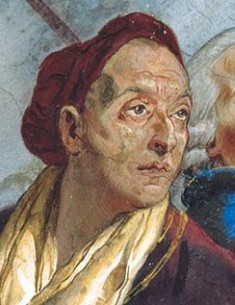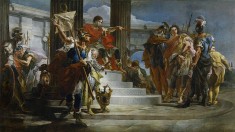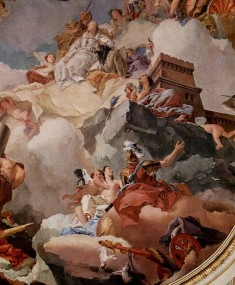| Giovanni Battista Tiepolo | |
|---|---|
 |
|
| Born | Mar. 5, 1696 Venice, Italy |
| Died | Mar. 27, 1770 (at age 74) Madrid, Spain |
| Nationality | Italian |
| Movement | Baroque |
| Field | Painting |
| Works | |
Giovanni Battista Tiepolo was born in Italy in 1696. He died in 1770. He is also referred to as Giambattista Tiepolo, or simply Gianbattista at times. He was not only an Italian painter, but he was also an artist who created etchings. Many consider this artist to be the best European painter of the 18th century.
Tiepolo’s Early Life
Tiepolo was born to a noble and wealthy family in Venice, Italy. He became a student of Gregorio Lazzarini, who was a successful and renowned painter of the day, in 1710. Tiepolo’s earliest works of art included depictions of the apostles which were painted for a church in Venice. In 1716, Tiepolo painted his first of many frescoes on a church’s ceiling at Biadene. In 1719, he joined the Venetian Guild of Painters.
From 1719 to 1720, Tiepolo painted many frescoes for a palace owned by Giambattista Baglione, a wealthy publisher. He created the Triumph of Aurora and the Myth of Phaethon on the palace’s ceiling and walls respectively. Tiepolo also designed beautiful spatial illusions that soon became a frequent theme throughout his life.
Tiepolo’s Personal Life
Tiepolo married Maria Cecilia Guardi in 1719. She was the sister of Francesco and Giovanni Guardi, who were also artists. The marriage produced nine children and seven of them survived into adulthood. Two sons, Lorenzo and Domenico, worked as Tiepolo’s assistants and went on to achieve their own recognition.
Tiepolo’s Major Works
 In 1725, Giovanni Tiepolo received his first fresco commission for a palace in Udine. These frescoes showed his wonderful ability to depict the various tones of pale colors which were far different than the darker Piazettesque designs he had previously studied. The Udine frescoes displayed steep perspectives that had structures shrinking into the distance. These architectural perspectives were mostly painted by Mengozzi-Colonna, a painter that worked for Tiepolo for many years.
In 1725, Giovanni Tiepolo received his first fresco commission for a palace in Udine. These frescoes showed his wonderful ability to depict the various tones of pale colors which were far different than the darker Piazettesque designs he had previously studied. The Udine frescoes displayed steep perspectives that had structures shrinking into the distance. These architectural perspectives were mostly painted by Mengozzi-Colonna, a painter that worked for Tiepolo for many years.
His first masterpiece was a series of paintings for a massive reception area at the Ca’ Dolfin. They depicted historic battles and victories of the Roman Empire. His early masterpieces brought him substantial commissions. He also painted many canvases during the 1730s for churches, which included the Scuola dei Carmini and the Chiesa degli Scalzi.
Tiepolo spent several years traveling mostly in Northern Italy. During this time, he created many frescoes in churches and palaces. He also produced works of art in oil, including the Sacrifice of Melchidezek, and the massive Gathering of the Manna. These were created for the parish church in Verolanuova and each one stands about 32 feet high. Other frescoes during this period include the beautiful Antony and Cleopatra collection which was finished before he left for Würzburg.
The high point of his career was the ceilings that he painted from 1750 to 1753 at the Residenz in Würzburg, Germany. He created a scene that portrayed Apollo and the different continents of the world. This work measured over 7,000 square feet when it was finished. The palace is an excellent model of German Rococo architectural mastery and this mixture of painting and architecture is considered by many to be the best work of Tiepolo’s career.
Tiepolo’s Etchings
 Tiepolo created two groups of etchings. The Scherzi di fantasia and the Capricci. Ten of the Capricci etchings were released by Anton Maria Zanetti. The topic of these works was very imaginary and they reminded people of work done by Giovanni Benedetto Castiglione and Salvator Rosa. The Scherzi series took 10 years to complete and it was published after his death. Subjects in the etchings included many mystical Eastern figures and some prints had scenes of necromancy.
Tiepolo created two groups of etchings. The Scherzi di fantasia and the Capricci. Ten of the Capricci etchings were released by Anton Maria Zanetti. The topic of these works was very imaginary and they reminded people of work done by Giovanni Benedetto Castiglione and Salvator Rosa. The Scherzi series took 10 years to complete and it was published after his death. Subjects in the etchings included many mystical Eastern figures and some prints had scenes of necromancy.
Tiepolo’s Later Years
Charles III of Spain commissioned Tiepolo to design a ceiling fresco for his throne room in the Royal Palace in 1761. The king also commissioned several altarpieces to be made for the Aranjuez. While Tiepolo was there, he also produced several private commissions. In March of 1770, the prolific artist died in Madrid.
Tiepolo’s legacy includes over 800 paintings, 2,000 drawings, and two etching sets. There are also acres of luminous frescoes that carry his name that adorn many churches, villas, and palaces.
One reason that he was able to complete so many frescoes and other works was because he painted or sketched small models for his clients to approve. He then had many skilled assistants that helped him to complete the work, including two of his sons.
Giovanni Battista Tiepolo is still regarded as one of Italy’s most important artists. Many consider his greatest works to be the frescoed ceilings that he painted for many churches in Venice as well as for the villas in Italy, Spain, and Germany.